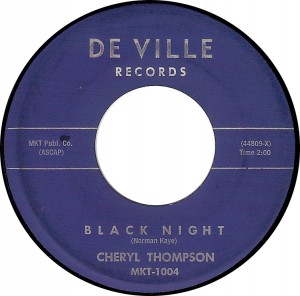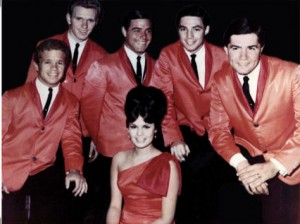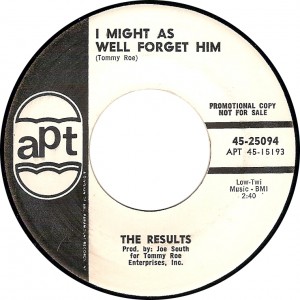This is one of those weeks where three records get posted alongside each other not because they share some very specific theme or belong, musically- or culturally-speaking, in the same sub-sub-genre. (Jazz, early rock ‘n’ roll, pop, R&B and country all get represented in one form or another here, and in different proportions.)
Rather, they’re grouped together because they fit that way in my mind. There is some logic at work here, though, some shared sensibility that was in play in the post-War decades. Patsy Cline’s “Walking After Midnight” and Peggy Lee’s “Why Don’t You Do Right” belong somewhere along this axis of atmosphere. So do Wanda Jackson’s “Funnel of Love” and Etta James’s “One For My Baby (And One More For The Road).” So do countless female versions of “Summertime,” “Black Coffee” and “Fever.”
Nervous and bittersweet, too fast to be torch songs, too relaxed to be barnstormers, this week’s selections are, in the end, all nocturnal anthems of a sort, collectively oozing mood and sensuality.
 1. Cheryl Thompson, Black Night (Deville MKT-1004)
1. Cheryl Thompson, Black Night (Deville MKT-1004)
Born in 1944 in Florida, Cheryle Thompson made her way to Las Vegas in 1962 to pursue a singing career. Initially landing work as a showgirl at the Sahara Hotel and Casino, Thompson soon met singer and bassist Norman Kaye, who, along with his sister, anchored the popular Mary Kaye Trio, one of the early lounge combos supplying the swinging, round-the-clock soundtrack for post-War Las Vegas.
Thompson’s first major exposure came in 1963 and 1964, when she was selected as Miss Las Vegas and Miss Nevada. At a time in post-War popular culture when pageants represented a more viable launching pad for acting and music careers, Thompson was able to parlay her talents and new-found visibility, along with her connections through now-husband Kaye, into several recording deals. Among them was the excellent “Don’t Walk Away” (b/w “It’s the End”), a Kaye composition that was released in 1965 on Chicago’s Vee Jay Records and that featured Thompson’s aching, Patsy-Cline-influenced vocals and an effective soul-pop arrangement.
Three more singles followed a year later on Decca Records (and its subsidiary Coral Records). Cut very much in big-production Nashville countrypolitan mode, these included the modest 1966 hit “The Third Person,” which Thompson co-authored.
“Black Night” is the most obscure of Thompson’s sides. It seems to have been Thompson’s very first recording, and while it’s tough to pinpoint its exact recording date, it did see release in 1964 (including a U.K. issue). Most importantly, it’s a terrific record, a wicked intersection of rock ‘n’ roll, atmospheric pop and Nashville-style production values.
The 1960s passed and family life called, and Thompson effectively retired from the music business, joining Kaye in managing their expanding real estate business. Cheryle Thompson passed away in 2003 in Las Vegas.
Sources: Las Vegas Sun
 2. Honey Sanders, Some Like It Cool (Brighton 777-A)
2. Honey Sanders, Some Like It Cool (Brighton 777-A)
Honey Sanders was a singer, actress and entertainer first and a recording artist second.
Born in 1927, Sanders evinced musical talent from an early age, and came up in New York City show business. And Sanders – some time in the ‘50s for child-rearing notwithstanding – would remain in that world, returning to the stage in the late ‘50s, with various theatre and Broadway appearances over the next decade or two. (If period accounts are to be trusted, she was sometimes finding roles as the “jolly fat type.”)
Released in 1963 on the obscure New York City-based Brighton Records label, the seldom-heard “Some Like It Cool” and its flipside “(Johnny Guitar) My Restless Lover” were both penned by songwriter, composer and conductor Pembroke Davenport, another Broadway veteran. “Some Like It Cool,” featuring Sanders’s sultry, coolly understated vocal, is not only one of the more effective recorded turns by a theatre-based vocalist, but – with its jazzy sensibility, tight guitar interplay and some atmospheric bongos pattering through its three minute course – it’s one of the hippest, too.
Sanders would go on in the ’80s to open the Sanders Agency, a theatrical talent agency, in New York and Los Angeles. She continued in the theatre world as a producer as well, remaining active from the ‘90s onwards before her death in 2003.
“Some Like It Cool” would be Honey Sanders’s only solo recording.
Sources: Variety
 3. Barbara Pittman with Gene Lowery Singers, Handsome Man (Phillips International 3553)
3. Barbara Pittman with Gene Lowery Singers, Handsome Man (Phillips International 3553)
Singer Barbara Pittman is best remembered for her handful of excellent 45s recorded for Sam Phillips’s legendary Sun and Phillips International labels between 1956 and 1960.
Pittman was born in 1938 and grew up musically inclined, one of twelve children in a large, poor family from North Memphis. Unlike many of the white kids who went on to record for the Memphis-based Sun Records, Pittman wasn’t necessarily a country- or gospel-raised singer first – she was drawn early on to big band sounds and blues.
Which isn’t to suggest Pittman couldn’t sing country. After initially being rebuffed by Sun, Pittman dug in, building her chops with two different Western groups, Clyde Leoppard’s Snearly Ranch Boys and Lash Larue. With the former group Pittman recorded her first record in 1956, after finally convincing Sam Phillips. “I Need a Man,” a rare female rock ‘n’ roll release for Sun Records, epitomized the label’s classic aesthetic – all lusty vocals, slapback bass and wild guitar and piano.
Over the next few years a small schedule of Sun 45s ensued, none of them particularly commercially successful. There would be some missteps (the overwrought “The Eleventh Commandment”), along with some more great rock ‘n’ roll (the Jerry-Lee-Lewis-inspired “I’m Getting Better All the Time”) and several excellent ballads (“No Matter Who’s to Blame,” “Two Young Fools in Love,” “Cold Cold Heart.”)
“Handsome Man,” released in 1960, was Pittman’s fourth and final record for Sam Phillips. I’m in the minority here but for me it ranks as the most attractive side in Pittman’s discography. Penned and arranged by the Charlie Rich, still a young Memphis session whiz at this point, “Handsome Man” didn’t draw directly from Sun’s chart-proven country or rock ‘n’ roll style. It rocked in its own way, but Pittman’s sultry, assertive lead vocal and Rich’s complementary support put its sensibilities somewhere closer to torch-lit clubland.
Pittman moved to California in 1962 and found work there as a session musician and club singer. While she never enjoyed breakthrough success, she remained committed to a singing career, and, after marrying and moving to Houston, would reestablish herself in the early ‘80s with a set of younger fans of early rock ‘n’ roll.
Barbara Pittman passed away in 2005 at the age of 67.
Sources: Elvis Australia, Rockabilly Hall of Fame











![Mike Baltch Quartet: "Delilah" [Green Dent 1008] Mike Baltch Quartet: "Delilah" [Green Dent 1008]](http://web.archive.org./web/20120805023927im_/http://officenaps.com/wp-content/uploads/2012/06/mikebaltchquartet_delilah1-297x300.jpg)
![Mike Baltch Quartet: "Delilah" [Green Dent 1008] Mike Baltch Quartet: "Delilah" [Green Dent 1008]](http://web.archive.org./web/20120805023927im_/http://officenaps.com/wp-content/uploads/2012/06/mikebaltchquartet_delilah_cover-298x300.jpg)
![Mike Baltch Quartet: "Delilah" [Green Dent 1008] Mike Baltch Quartet: "Delilah" [Green Dent 1008]](http://web.archive.org./web/20120805023927im_/http://officenaps.com/wp-content/uploads/2012/06/mikebaltchquartet_delilah_backcover-297x300.jpg)
![Orpheus Four: "Caverns" [Orpheus OR-101-B] Orpheus Four: "Caverns" [Orpheus OR-101-B]](http://web.archive.org./web/20120805023927im_/http://officenaps.com/wp-content/uploads/2012/06/orpheusfour_caverns-297x300.jpg)
![Ross Anderson Chorus and Orch.: "Tam-bu Theme" [Channel 45-7002] Ross Anderson Chorus and Orch.: "Tam-bu Theme" [Channel 45-7002]](http://web.archive.org./web/20120805023927im_/http://officenaps.com/wp-content/uploads/2012/06/rossandersonchorusandorch_tambutheme-300x300.jpg)











